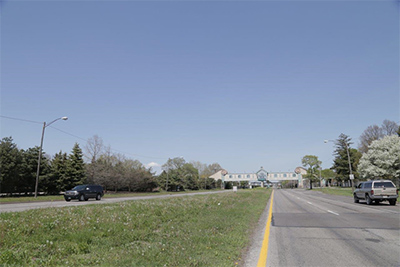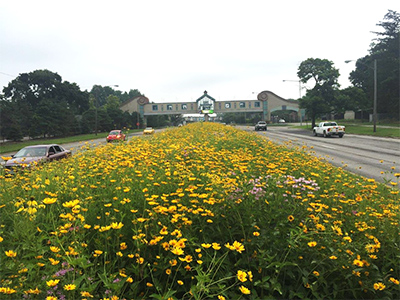Native Plant Conservation Campaign News: Lawns are not only unhealthy for people, wildlife and the planet, they are expensive. Why not replace them with natives?
October 7, 2020
"GENTLEMEN, lay down your lawnmowers. …replant all or part of your yard with native flora, which requires less water and less maintenance …, and can foster a more functional ecosystem" so started a recent
article in Men's Journal, confirming the widening awareness that
lawns are "so last millenium".
Much has been written on the environmental costs of lawns (see e.g. books by
NPCC Advisor Doug Tallamy, or his
video presentations). Now, case studies show that in addition to improving air and water quality, reducing erosion and flooding, and supporting pollinators, songbirds and other

wildlife, replacing lawns with locally appropriate native plants also saves money!
Case Study 1
From 2004 to 2013, Santa Monica College in California
compared two gardens on campus in collaboration with the City of Santa Monica and the Metropolitan Water District of Southern California. The project was designed to test a “native” vs. a “traditional” garden.
The Native Garden was designed to be climate-appropriate and sustainable, based around local native plants replicate local chaparral ecosystems. The project included a dry creek bed and infiltration pit to keep rainwater on site.
The Traditional Garden featured popular garden plants, primarily from Europe and the Eastern U.S., and used standard sprinkler irrigation. Ninety-five percent of the “Traditional” garden was lawn. Following Santa Monica city policy, no chemical pesticides or herbicides were used in either garden.
After establishment, the Native Garden received a yearly pruning and once per-month maintenance. Irrigation was provided by a weather-based controller with low-volume drip irrigation. In the Traditional Garden, the sprinkler system was wasteful and the exotic plants required more water, fertilizers, and pest management. Lawns were mowed weekly and annual plants were replaced two to three times a year as needed. Occasional treatments were required for disease and insect attacks.
The study found that “the sustainable landscaping principles demonstrated in the Native Garden, are cost-effective, environmentally beneficial, and easy to replicate.” On average
the Native Garden used 83% less water; required 68% less maintenance than the Traditional Garden, and generated 56% less green waste (such as lawn clippings.) A recent
article reported that yard waste constitutes 20 to 50% of US landfill.
Case Study 2
This year the Xerces Society for Invertebrate Conservation produced a
Guide For Creating And Maintaining Mid-Atlantic Native Meadows. The goal of the Guidebook was to encourage land managers to convert turf and other ecologically damaged lands to native meadows in order to create habitat for pollinators and other wildlife. Guidebook authors Stephanie Frischie and Alice Sturm estimated the relative costs for installing and maintaining traditional turf lawn vs. seeded

native meadow. They estimated that
over a 20 year period, conventional lawn cost up to $5815.00/acre/year whereas seeded native meadow cost $1012.00/acre/year.
The authors note that much of the cost savings is due to the fact that healthy diverse native plant communities need almost no expensive and polluting chemical inputs whereas lawns require large quantities fertilizers and pesticides as well as frequent labor to mow and to apply chemicals (see below).
In General
Data such as these on the costs of lawns vs. native gardens are still sparse. However, we do know some things:
- The U.S. invests between $30 and$60 billion per year in turfgrass, including lawn care products and lawn care companies, according to the Economic Research Service and other sources.
- A 2005 NASA study found that, in terms of surface area, residential and commercial lawns are the single largest irrigated crop in America.
- Dr. Tallamy frequently states in his books and presentations that turfgrass covers more than 40 million acres in the United States, an area the size of New England. We are adding 500 square miles of it each year.
- A lawn mower pollutes as much in one hour as 40 automobiles driving
- 30-60% of urban fresh water is used for watering lawns
- 67 million pounds of pesticides are used on U.S. lawns each year
- 580 million gallons of gasoline are used in lawnmowers each year
- The Natural Resources Defence Council adds: every year U.S. lawns consume nearly 3 trillion gallons of water.
Native plantings deliver numerous ecosystem services in addition to supplying pollinator, songbird and other wildlife habitat. According to the
Environmental Protection Agency, native plantings are superior to non natives in erosion and flood control, climate resilience, and in sequestering greenhouse gasses. Soils under established prairie grasslands , for example, can contain more than 10 tons roots per acre, and some prairie plant roots extend to a depth of 10 feet or more, storing up to
1.7 metric tons per acre per year.
Most lawn grasses have much shallower and less dense root systems and so store less carbon.
We hope that this information will help and encourage us all to work in our gardens, communities, and with decisionmakers to replace lawns with native plants.
Resources and additional information:
Photos: Turf median, same median planted with natives. © Doug Tallamy
2020 May be the most important election in our lifetimes
But, due to COVID-19 and to voter suppression efforts such as defunding the Post Office,
*many elections are being rescheduled,
*voting places moved, and
*rules are changing.
We want to help people stop worrying about how, when and where to vote!
 |
Excercise your right to vote and help your friends, family and colleagues VOTE SAFELY AND WITH CONFIDENCE
- assistance with voter registration or confirmation that your registration is accurate and current
- assistance and updates to keep up to date with changing local voting rules, procedures and locations, and
- NONPARTISAN tools to learn about issues and candidates
Image © Chris Benda, Illinois Native Plant Society
|
 wildlife, replacing lawns with locally appropriate native plants also saves money!
wildlife, replacing lawns with locally appropriate native plants also saves money! wildlife, replacing lawns with locally appropriate native plants also saves money!
wildlife, replacing lawns with locally appropriate native plants also saves money! native meadow. They estimated that over a 20 year period, conventional lawn cost up to $5815.00/acre/year whereas seeded native meadow cost $1012.00/acre/year.
native meadow. They estimated that over a 20 year period, conventional lawn cost up to $5815.00/acre/year whereas seeded native meadow cost $1012.00/acre/year.